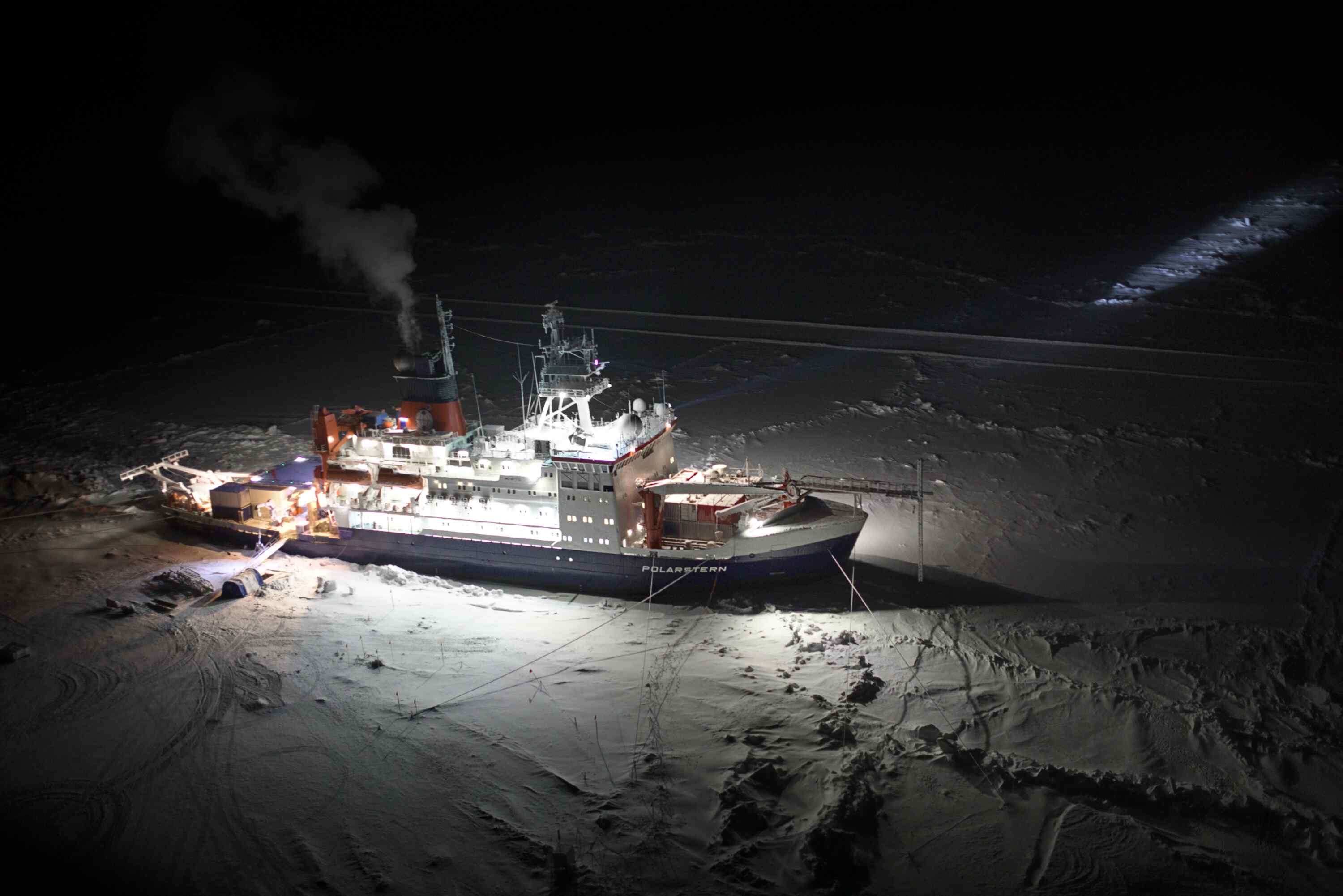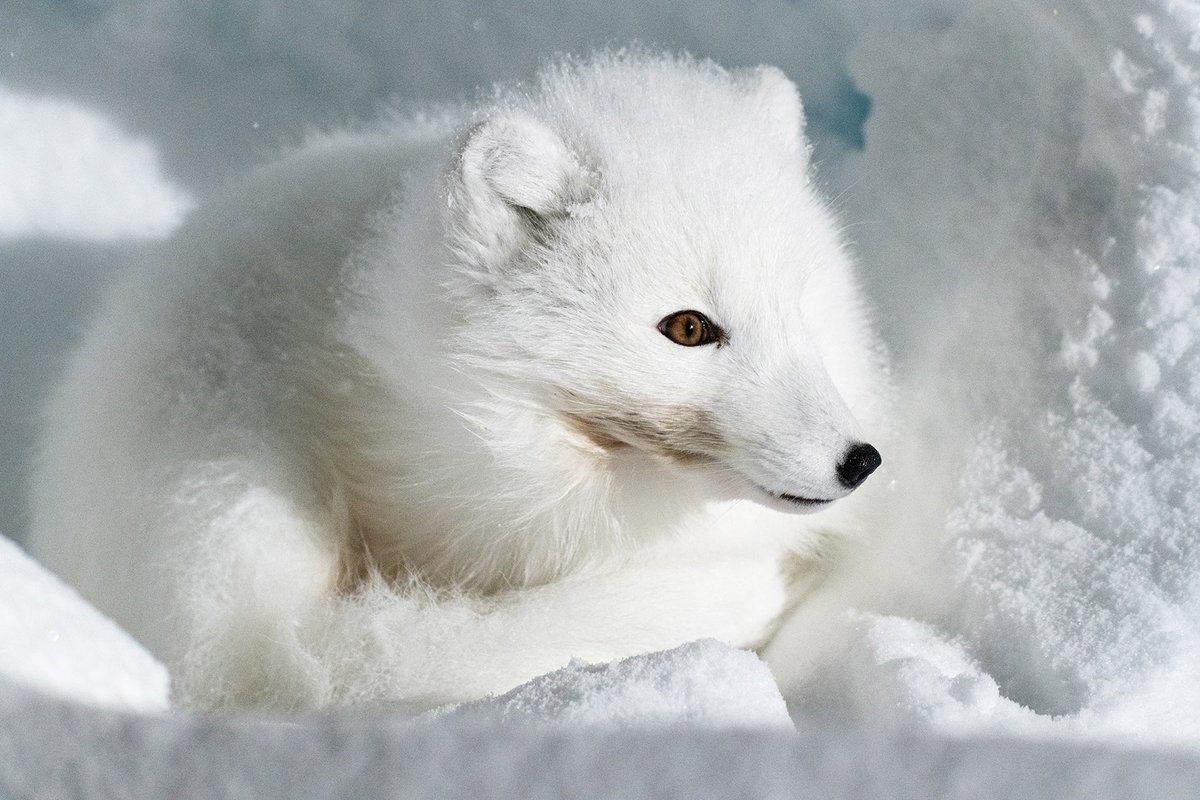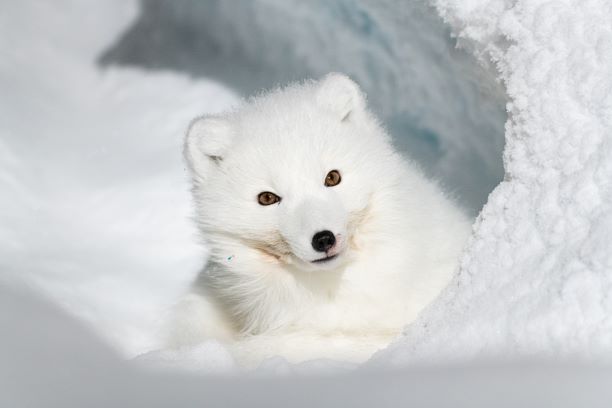Monthly Expedition Update
To the Extremes of the Earth
On January 8th, the Polarstern was officially farther away from civilization than the International Space Station, which orbits at an altitude of ~400 km (~250 miles) above the Earth's surface! This extreme isolation means that there must be a plan in place in case there is an emergency on the ship where someone needs to be transported quickly back to land. In the photo above (taken by Michael Gallagher aboard one of the expedition helicopters), you can see the recently constructed runway that was built for small planes to land in case of such an emergency. The runway is 400 m (>1300 ft) long and 25 m (~82 ft) wide, and was cleared by a 'PistenBully,' a machine used to groom ski slopes. This might qualify as the world's most remote airplane runway!
 Quick Bite: On (Thick or) Thin Ice
Quick Bite: On (Thick or) Thin Ice
How thick must sea ice be to support a small airplane?

h=√(P/A) is a basic formula (sometimes called 'Gold's Formula') that can be used to calculate the ice thickness (h) that is needed to support a specific load (P), or weight of something. A in this equation is a constant that is related to assumptions about the nature of the ice (is it very cold and hard, is it thawing and weak, or is it somewhere in between)? We recommend using a value of 50 psi (pounds per square inch) for A, which is a conservative value for thawing (and thus the least strong) ice.
First, make a guess as to what you think the minimum thickness the sea ice underneath the runway must be to support the plane.
Then, calculate the actual minimum thickness the sea ice underneath the runway must be, assuming that the MOSAiC team wants it to be able to support a Twin Otter plane that weighs ~8,000 lbs. Does the answer surprise you? Is it similar to or different from what you guessed?
Find out how thick the ice under the runway actually is
Photo (R): AMRC & AWS blog post by Carol Costanza, UW-Madison
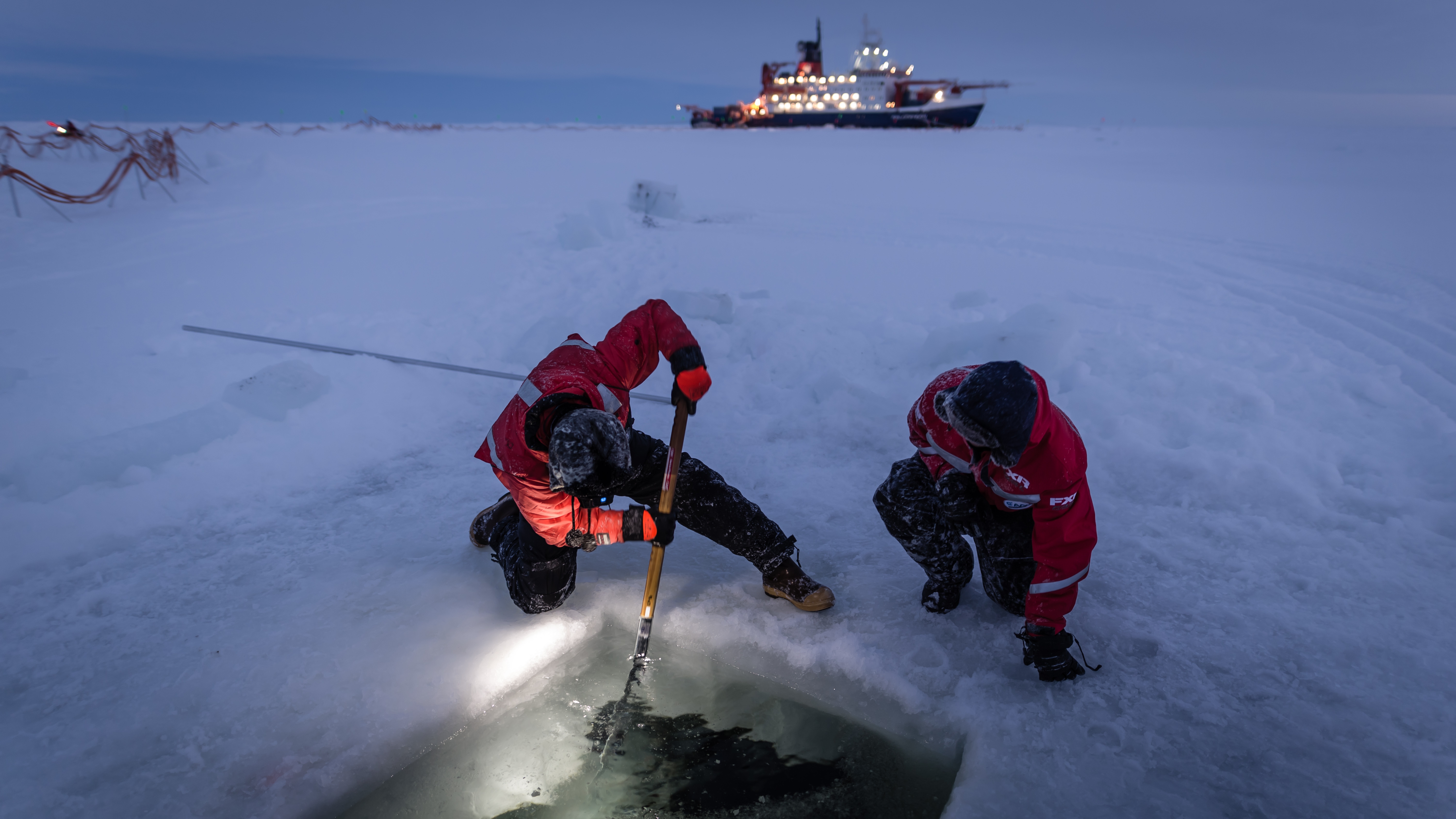
Photo (L): Scientists on the sea ice during Leg I of MOSAiC; Credit: Stefan Hendricks
Did You Know?
There is one airport in the contiguous United States (lower 48 states) that has an official runway built on ice! The Alton Bay Ice Runway and Seaplane Base in New Hampshire maintains a runway on an ice-covered lake in the winter that is 100 feet wide and 2,600 feet long. Learn more about the runway and what it's like to land on ice (video included!) below!
About the Alton Bay Ice Runway
![]()
![]()
 #askmosaic: An Adorable Menace
#askmosaic: An Adorable Menace
This week's question was submitted by Malachi from Middleton Middle School: Have you been able to spot wildlife other than polar bears and sea animals?
On Monday (January 6th) we discovered another victim of "the number one MOSAiC leg 2 enemy": Two power cables of a battery set and the rope handle of the box they are stored in were destroyed. Polona Itkin from Team ICE reports: "Today we also found S1 [a Global Navigation Satellite System station] dead...there was even some white hair on it!" The latter is a clear sign of the offender: the Arctic fox. This all white, beautiful animal created a lot of trouble on the ice floe in the end of December, when it nibbled on data and power cables and thus disconnected the meteorological measurements in MET City from the network and created a lot of damage there as well as at the remote sensing site. We were able to scare it away after it first seemed it would only like to play with us. We would like to have another visit of one of these beautiful animals - but would prefer having an individual with different taste!
-Current (Leg II) crew of the Polarstern, as reported in the MOSAiC daily blog. These photos are of the actual fox in question, taken by Michael Ginzburg, a photographer on the ship. If you look closely in one of the photos, you'll see a speck of blue on the fox's right shoulder--this is insulation from the cables it chewed!
Follow the MOSAiC Web App to read the MOSAiC daily blog
Submit your #askmosaic questions!
 In the Classroom: Arctic Adaptations
In the Classroom: Arctic Adaptations
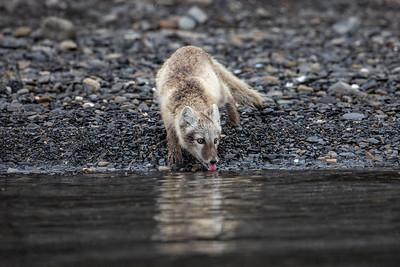
As you can see in the photos above, the mischievous Arctic fox causing some issues for MOSAiC has a beautiful stark white fur coat. Did you know that as the seasons start to change and summer rolls around, the Arctic fox's fur coat will change from white to brown? Teachers, ask your students to spend a few minutes talking with a classmate about why they think this is. Then, discuss as a class. What purposes does the color of an animal's coat serve? What happens during seasonal changes in places like high latitude regions that might warrant the fox's wardrobe change?
Photo credit: Gregoire Dubois
Read more about how climate change could impact animals like the Arctic fox
![]()

![]()
 MOSAiC Weekly Tracking
MOSAiC Weekly Tracking
Plot the Polarstern
Download the map to plot coordinates
Download a larger map of the Arctic for a bigger picture view of the expedition area
Location of the Polarstern
| Date | Latitude | Longitude |
| September 16, 2019 | 69.68 N | 18.99 E |
| September 23, 2019 | 72.31 N | 26.93 E |
| September 30, 2019 | 85.12 N | 138.05 E |
| October 4, 2019** | 85.08 N | 134.43 E |
| October 7, 2019 | 85.10 N | 133.82 E |
| October 14, 2019 | 84.85 N | 135.03 E |
| October 21, 2019 | 84.97 N | 132.73 E |
| October 28, 2019 | 85.47 N | 127.07 E |
| November 4, 2019 | 85.88 N | 121.70 E |
| November 11, 2019 | 85.82 N | 116.00 E |
| November 18, 2019 | 86.05 N | 122.43 E |
| November 25, 2019 | 85.85 N | 121.35 E |
| December 2, 2019 | 85.97 N | 112.95 E |
| December 9, 2019 | 86.25 N | 121.40 E |
| December 16, 2019 | 86.62 N | 118.12 E |
| December 23, 2019 | 86.63 N | 113.20 E |
| December 30, 2019 | 86.58 N | 117.13 E |
| January 6, 2020 | 87.10 N | 115.10 E |
| January 13, 2020 | 87.35 N | 106.63 E |
| January 20, 2020 | 87.42 N | 97.77 E |
**Day when MOSAiC reached the ice floe that the Polarstern will become frozen in and drift with for the next year.
Log MOSAiC Data
Download a MOSAiC Data Logbook to keep track of Arctic conditions over the course of the expedition
**The Data Logbook has been updated for 2020!
| Date | Length of day (hrs) | Air temperature (deg C) at location of Polarstern | Arctic Sea Ice Extent (million km2) |
| September 16, 2019 | 13.25 | High: 10 Low: 4.4 | 3.9 |
| September 23, 2019 | 12.35 | High: 6 Low: -1 | 4.1 |
| September 30, 2019 | 9.1 | -4.7 | 4.4 |
| October 4, 2019** | 6.27 | -13.0 | 4.5 |
| October 7, 2019 | 3.05 | -8.2 | 4.6 |
| October 14, 2019 | 0 | -14.7 | 4.8 |
| October 21, 2019 | 0 | -12.8 | 5.4 |
| October 28, 2019 | 0 | -18.3 | 6.8 |
| November 4, 2019 | 0 | -18.9 | 8.0 |
| November 11, 2019 | 0 | -25.5 | 8.7 |
| November 18, 2019 | 0 | -10.7 | 9.3 |
| November 25, 2019 | 0 | -18.4 | 10.0 |
| December 2, 2019 | 0 | -26.6 | 10.4 |
| December 9, 2019 | 0 | -23.1 | 11.2 |
| December 16, 2019 | 0 | -19.2 | 11.8 |
| December 23, 2019 | 0 | -26.9 | 12.2 |
| December 30, 2019 | 0 | -26.4 | 12.6 |
| January 6, 2020 | 0 | -28.0 | 13.0 |
| January 13, 2020 | 0 | -30.7 | 13.1 |
| January 20, 2020 | 0 | -27.1 | 13.6 |
*Note: We expect data to fall within the following ranges: Length of day, 0-24 hours; Temperature, -40 to 14 degrees C; Sea ice extent, 3-15 million km2
**Day when MOSAiC reached the ice floe that the Polarstern will become frozen in and drift with for the next year.
 MOSAiC + Reach the World
MOSAiC + Reach the World
Exciting news! The MOSAiC education & outreach team is partnering with Reach the World to connect more classrooms to the MOSAiC expedition. Over the coming months, Reach the World will share MOSAiC team members' incredible stories about the expedition, its research, and the everyday challenges of life in the Arctic. This STEM-rich virtual exchange will combine written articles published here and interactive video calls with MOSAiC team members as they cycle off of Polarstern and return to their homes around the world. Want to know if Arctic ice is really melting, and if so, how we know? Curious about life aboard Polarstern and daily life on the ice? Join the expedition today, and you can learn from the experts themselves! Thanks to the generous support of the Elba Foundation, teachers can sign up for free here.
Follow MOSAiC with Reach the World
Sign up for Reach the World's Explorer Program
 MOSAiC Monday and the NGSS
MOSAiC Monday and the NGSS
What do those funny symbols below some engagements mean?
Good news for educators in the U.S. teaching with the Next Generation Science Standards (NGSS) or similar! We will now be tagging MOSAiC Monday engagements with the NGSS Disciplinary Core Idea subject(s), Science and Engineering Practice(s), and Crosscutting Concept(s) that they most closely connect to. Look for these symbols listed below each engagement:
Disciplinary Core Idea Subjects
Science and Engineering Practices (adopted from the San Diego County Office of Education Science Resource Center)
Crosscutting Concepts (adopted from the San Diego County Office of Education Science Resource Center)
Is there something you'd like to see in MOSAiC Monday? Let us know!
Send us your feedback
New to MOSAiC Monday? Check out past editions!
Browse more expedition-related educational resources, videos, and blogs
Email us! mosaic@colorado.edu

